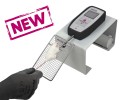Authors
LX Yang, FY Chen, HL Yu, et al
Lab
Department of Neurology, Drum Tower Hospital, Medical School and The State Key Laboratory of Pharmaceutical Biotechnology, Institute of Brain Science, Nanjing University, Nanjing, China
Journal
Annals of Translational Medicine
Abstract
Background Based on accumulating evidence, excessive activation of microglia-mediated inflammatory responses plays an essential role in ischemic stroke. Poncirin (Pon) exerts anti-hyperalgesic, anti-osteoporotic and anti-tumor effects on various diseases. However, the roles of Pon in microglial activation and the underlying mechanism have not been elucidated. This study aimed to explore whether Pon inhibits lipopolysaccharide (LPS)-induced microglial neuroinflammation and protects against brain ischemic injury in experimental stroke in mice.
Methods Primary microglia cells were prepared from the cerebral cortices of 1- to 2-day-old C57BL/6J mice. Murine BV2 cells and primary microglia were stimulated with LPS and the effects of a non-cytotoxic concentration of Pon on LPS-stimulated pro-inflammatory factors were measured using real-time PCR and enzyme-linked immunosorbent assays (ELISAs). Western blot analyses were used for mechanistic studies. In an in vivo study, 8-week-old male C57BL/6J mice were subjected to focal cerebral ischemia through middle cerebral artery occlusion (MCAO). Pon (30 mg/kg, i.p.) or the same volume of saline was administered after the MCAO model was established, and the infarct volume was evaluated using 2,3,5-triphenyltetrazolium chloride (TTC) staining. We also evaluated animal behaviours, the expression of pro-inflammatory cytokines and microglial activation in the ischemic hemisphere.
Results Pon prevented the release of nitric oxide (NO), prostaglandin E2 (PGE2), interleukin (IL)-1beta, IL-6 and tumor necrosis factor-alpha (TNF-alpha) in both BV2 cells and primary microglia stimulated with LPS. The inhibitory effects of Pon were associated with the regulation of the ERK1/2, JNK and nuclear factor kappa B (NF-kappaB) signaling pathways. In mice that underwent MCAO, Pon administration decreased the lesion size and improved neurological deficits. Furthermore, Pon attenuated the production of inflammatory cytokines mainly by restraining microglial activation after ischemic stroke.
Conclusions Based on the findings from the present study, Pon provides neuroprotection through its anti-inflammatory effects on microglia and it may be a useful treatment for ischemic stroke.
BIOSEB Instruments Used:
Grip strength test (BIO-GS3)

 Douleur - Allodynie/Hyperalgésie Thermique
Douleur - Allodynie/Hyperalgésie Thermique Douleur - Spontanée - Déficit de Posture
Douleur - Spontanée - Déficit de Posture Douleur - Allodynie/Hyperalgésie Mécanique
Douleur - Allodynie/Hyperalgésie Mécanique Apprentissage/Mémoire - Attention - Addiction
Apprentissage/Mémoire - Attention - Addiction Physiologie & Recherche Respiratoire
Physiologie & Recherche Respiratoire
 Douleur
Douleur Système Nerveux Central (SNC)
Système Nerveux Central (SNC)  Neurodégénérescence
Neurodégénérescence Système sensoriel
Système sensoriel Système moteur
Système moteur Troubles de l'humeur
Troubles de l'humeur Autres pathologies
Autres pathologies Système musculaire
Système musculaire Articulations
Articulations Métabolisme
Métabolisme Thématiques transversales
Thématiques transversales SFN2024: Venez rencontrer notre équipe sur le stand 876 à Chicago
SFN2024: Venez rencontrer notre équipe sur le stand 876 à Chicago 